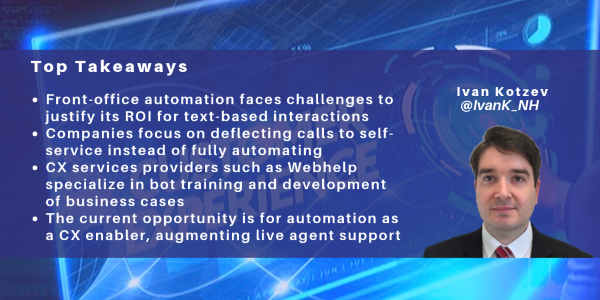posted on Sep 13, 2019 by Ivan Kotzev

The inevitable automation of the contact center role has become such as surefire prediction in mass media, by CEOs, and even politicians, that a more realistic view of the industry may seem impossible. In this blog, I look at Webhelp’s assessment of the CX automation landscape and the realistic challenges and opportunities in the market.
Customer-facing automation requires significant volumes
The majority of outsourced customer-facing automation implementations are around text communication. Chatbots, email bots, and increasingly messenger bots, are also an investment focus for CX services providers, offering more applicable business cases and quicker ROI. The challenge, however, is that phone interactions continue to dominate; for example, for Webhelp, voice represents ~85% of all volumes across their European markets. The shift from voice to non-voice is gradual and for many customers the phone remains the preferred channel to contact brands.
While variations between customer segments (e.g. Gen X and Z) and geographies (e.g. China) can place higher priority on text interactions, the biggest markets remain voice-centric. Automating voice-based scenarios are more complex and hence more costly, with the additional step of transcription and with low accuracy in many languages. A voice automation solution requires more than 100 hours of transcription on a given use case.
On the flip side, the growing adoption of messengers and digital voice speakers by customers can create the necessary potential scale of interactions to justify bot development.
Self-service vs. generic info automation
With the aim of removing repeatable and low-skilled inquiries, companies are investing in developing self-service journeys. Webhelp estimates that ~15% of interactions can be handled with self-service over the brand website with customer portals, FAQs, interactive tutorials and guides, and through mobile apps. The company provides consulting and advisory services to its clients to identify the relevant processes and customer journey steps to support with self-service, and then promote and redirect on the IVR and during live agent interactions. A common challenge here is that many brands struggle to link the web and contact center journeys and track KPIs by merging web and CRM data at scale. The company’s consulting agency, Gobeyond, has conducted such analysis and estimates that this ~15% potential applies across verticals.
The potential of conversational automation
The scenarios where the customer interacts with a robot, receives personal information, and completes the journey without human intervention are even fewer. Webhelp evaluates this potential at ~13% over the next three to five years. The main reason for this low target is that, for a true cognitive bot deployment, the client needs to reach digital transformation maturity; for example, with a CRM ready to connect to AI, centralized databases, and robust CX infrastructure. Other reasons include the high cost of the technical implementation and integration with various systems, the long deployment timeframe which, coupled with significant ambiguities or dynamics in the CX processes, makes them not ‘AI friendly’. A further barrier can be the risk of low customer satisfaction, especially in long multi-step scenarios.
The challenge with customer-facing robots is the need to synchronize the interaction between customer, live agent, and CX systems. In Webhelp’s experience, automation is successfully deployed mainly in back-office activities with heavy legacy of processes which are not aligned to the technology landscape; for example, in financial services.
Bot training and bot development
One of the advantages of CX services providers is they can offer sizable resources and domain experience in CX to train chatbots, with agents classifying conversations by intent, analysts creating the taxonomy, and data scientists developing the algorithms in-house. Webhelp began offering these services approximately two years ago with its Technology Enablement division. For example, for Merck in France, it developed a voice bot to answer calls from hospitals and pharmacies about medicine availability and expected delivery times. It coded around 300 medicine names and for each medicine, several dosage and packaging variations. It also developed the NLU model to understand the information. The algorithms further identify pharmacists eligible to access emergency stock.
Launched in June 2018, the bot currently handles ~100 calls daily, processing around half of the total volume. The implementation lowered the cost of operation, replacing the need for doctors and pharmacists from the company to manage calls. The company is now developing a web service, activate order taking, and plans to extend the opening hours.
Automation as a CX enabler
The area where automation is likely to bring the biggest immediate impact is in CX agent augmentation. Webhelp’s experience shows that different types of bots and ML analytics can increase FCR by ~15% when applied to QA, can reduce AHT by 25% with assisted response tools such as NBA, and can improve CSAT by leveraging NLP/NLU models to transcribe, classify, and analyze contact drivers. Next, the company has partnered with speech analytics provider Allo-Media to develop a real-time speech cognitive bot to proactively help agents during calls. Webhelp has identified three use cases: in dynamic sales inquiry checklist, customer data recap, and sales enablement materials. It plans to test the cognitive assistance in a lab environment by the end of the year and real-live implementations in 2020.
NelsonHall will publish a Cognitive Customer Experience Market Analysis report in Q4 2019.

